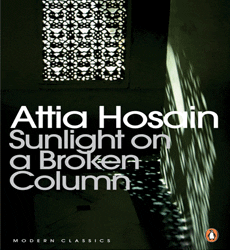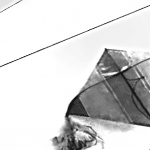The majority of Anglophone fiction in India in the 1950s and 1960s was based on the questions of nation and history. The Indian English writers were preoccupied with either partition narratives or national allegories. (Gopal) There were very few novels which could be described as ‘domestic’ fiction (meaning novels which were set in a domestic atmosphere and were concerned with social and inter-personal relations). Most of these novels were written by women and very few were in English. Writers like Rashid Jahan, Ismat Chughtai and Razia Sajjad Zaheer did write domestic fiction but all of these were in Urdu. Attia Hosain is one of the few, however, who decided to chose English as her literary language.
Sunlight on a Broken Column is Hosain’s first and only novel. It was first published by Chatto & Windus in 1961 and then reprinted by Virago in 1988 with an additional introduction by Anita Desai. It is the story of an upper-class Muslim family in transition. It is a cross between a memoir and a novel where a young woman relates the account of her growing up in a Talluqdar family in Northern India. Hosain was herself born into the class on which her novel is based and had complete knowledge and awareness about the topic she wrote about. The realistic and truthful description of the lives of the Talluqdars turns her work from a mere novel into a truthful document of its time.
The first half of the novel takes us through a gallery of timeless silhouettes of age-old traditions, customs, family relations and tensions, idiosyncratic relatives, wedding dramas and sombre funerals. The second half of the novel plunges the reader into a breathless succession of momentous events that leave the Talluqdar society into a flux. The very objective of this novel is to narrate changes which took place in the family, in the society and in the nation. These changes are described with the help of the characters and their actions and it is Hosain’s art of characterization which is the strongest point of the novel.
She reveals her characters through their conversations, their actions, and through a variety of point of views. The psychological and realistic portrayal of her characters is what makes them ‘Three-dimensional’. The characters come alive in flesh and blood as it were because of their realistic portrayal. The good ones are not paragons of virtue nor are the bad ones evil incarnates. Each character is a realistic mixture of good and bad traits. The characters are like real human beings, both pleasant and disgusting.
Hosain’s characters are individualized yet universal. They contain in themselves both the features of the type to which they belong and their personal eccentricities. She is sensitive to every nuance of manner and behavior, and any deviation from the standard is pointed out in a very subtle way. She builds her characters through piling an infinite succession of minute details about them and is constant in providing details about their outlook, attitude, manner and accomplishments.
Hosain’s work, consciously or unconsciously reflects the influence of the Persian literary style which she grew up reading. This novel brings the reader to a very close understanding of the Urdu novels written under Persian influence. Hosain herself acknowledges her debt to other women writers of the time like Rashid Jahan, Ismat Chughtai and Razia Sajjad Zaheer. She was also influenced by the Progressive Writers Movement as she reminisces “I was at the first Progressive Writers Conference (in1936) and could be called a ‘fellow traveller’ at the time.” (Desai). She was also influenced by reading of Afsanas or romances, which were a popular reading for young women of her generation which is evident in the treatment of Laila’s romance with Ameer.
Hosain conveys the personal and political turmoil that marked the partition of India through the coincidental dissolution of the Muslim landholdings and Feudal lifestyle. She takes a sensitive approach to the pain which echoed in the domestic realm. Her novel is a faithful and authentic testament of the dashing and sophisticated lives of the landed aristocracy before, during and after the partition of the subcontinent.
Anita Desai in the Introduction to Attia Hosain’s Sunlight on a Broken Column describes the novel as a monument to the past. Desai further adds, “To read them is as if one had parted a curtain, or opened a door, and strayed into the past.” (Desai). This description is most appropriate as Hosain’s novel takes us into the glamorous and fascinating world of the landowning class of the Talluqdars in Colonial India. Her novel skillfully reflects the social and cultural reality of the colonial times through the characters and their actions. The novel is set in Lucknow and showcases the turmoil and difficulties faced by the family of the protagonist, Laila, during the Indian independence struggle.
We are given a chance to look upon the lives of three generations of the family of Talluqdars in this novel. Each generation is very different in manner and habits from the previous one. There are a few main characters in each generation who reflect and highlight the culture and customs of their generation.The first generation of characters are those who have lived and experienced the glory and magnificence of being Talluqdars and who still strongly believe in the traditional ideologies of the old world. The second generation consists of those who are torn between two worlds- British and Indian. They know that the world they grew up in is on the decline but there is not much they can do except, adjust to the change in the hope of maintaining their old position. The third generation of the family consists of those who realized the importance of carving out their own place in a society full of turmoil and survived the downfall of the old world.
The representatives of the first generation are Babajaan, Thakur Balbir Singh and Raja of Amirpur who believe in the old world, its charm and powers. They hold the concepts of ‘Sharam’ and ‘Izzat’ above everything else and continue to follow the old ways throughout their lives in the face of any and all changes. They were the Lord and Masters; their word was the command and it was the highest degree of sin to challenge their notions of virtue and propriety. They had integrity and dignity in their character and were respected by everyone. Their family’s honour was all that mattered to them and their ancient minds believed that the rules of conduct of their world should be followed without any questions. They exercised almost unchallenged and tyrannical control over their household and estates.
Socially, their lives were filled with excesses. Many immersed themselves completely in lives of decadence and debauchery and squandered their wealth on unnecessary extravagances but, there were also those who engaged in philanthropical ventures such as building schools, places of worship, etc. and taking an active and faithful interest in the lives of their tenants. Abdul Halim Sharar in his book Lucknow: The Last Phase of an Oriental Culture describes the affluent and luxurious lifestyle of this class of people as those who did not care about the source of their wealth but only about spending it. These landlords were on good terms with both the British and the Hindus and invited them to their estates on various festivals, functions and social ceremonies.
Most of the Talluqdars resided in small towns called Qasbahs outside the city limits. They were the lord and masters of these qasbahs and held complete control over each and any of its workings. These qasbahs played an important role in providing local religious leadership and spreading religious learning amongst the people living in these areas. They were a dominant group and many of them emerged as strongholds of Muslim political movements during the Indian independence and partition.
Another common custom for these Talluqdars was mixing with courtesans. These courtesans however, were not merely workers of the flesh trade but highly educated and refined women. They were very well versed in the art of poetry and were accomplished vocalists and dancers. They were employed by Talluqdars to teach manners and refinement to their sons. One representative of this class in the novel is Mushtari Bai. It is interesting to note that there was in fact a courtesan named Mushtari who lived in Lucknow (Sharar 145). The Mushtari Bai of the novel had once been very rich and was employed by Babajaan to teach etiquettes and courtesy to his sons. She sang and danced at the wedding feasts held in the houses of Talluqdars and carried herself with such dignified airs that no one could suspect, if they did not already know, that she was not a ‘lady’. However, due to an illness she lost her voice and at present had turned to God to expiate her sins. She gave away all her wealth which she considered tainted by an unholy profession and became a “wandering mendicant” (Hosain 66).
The second generation of the family is the product of the mixture of the old and the new world. It has grown up in an atmosphere filled with a mixture of old traditions and new customs. This generation is perhaps the one which has been affected the most by the end of the British rule in India for some of them were able to adjust to the change but others continued living in the shadows of the old world in a miserable state.
The second generation of the family brings us face to face with, not one but two types of characters. The first set of characters are those who accepted the ways and customs of their ancestors without any questions and lived accordingly. The second set of characters are those who were given a chance to mix with the new world and upon mixing and knowing the new world, they decided to abandon the old world and its archaic ideas in favour of the new customs. However, as much as they liked to think of themselves as modern, they still were a part of the old world whose ways were deeply embedded in their hearts and minds.
One of the most interesting characters of this generation is Mohsin who accepted the old way of life without any questions and opposed anything and everything that threatened to expose the weak foundation of his world. He was a greedy and opportunistic man who lived in the city with his friends and relations and mixed freely with the dancing girls while his wife lived a pitiful life and “knew her husband only to conceive a child after each infrequent visit home.” (Hosain 21). He presents to us the ugly face of his class who lived on the income from their land and never did any work. He scorned anything that was modern and was strongly against the education and upliftment of women. He looked down upon the people of lower class and thought of them as mere slaves who lived to provide him comfort and satisfy his primitive needs. He tries hard to emulate the ways of his predecessors but fails miserably and in turn is reduced to being an impostor who only cares for his well being and pleasure.
It is the third generation of the family that consists of the most interesting and colorful characters. They are the ones who have grown up in a mixture of two worlds. They begin to question the basic principles on which their class had built up the social hierarchy. They are influenced by the ideas of freedom and equality that they imbibed through the western education they were given at school and college. There are a variety of characters in this generation ranging from the Nationalistic Asad to the Communalistic Saleem, the frivolous Zahra and the earnest Laila. The myriad of characters paint a beautiful and realistic picture of the society and the turmoil that it faced at the height of the Indian independence movement.
Laila, the protagonist of the novel, through whose eyes we get the glimpse of the world of the Talluqdars is “a troubled, thoughtful child…” (Desai). She is constantly caught up in the confusion of whether to follow what she thinks is right or what the society considers appropriate. She was orphaned at an early age and had lived with her grandfather and aunts since. She had always been quiet and docile and had mostly kept her thoughts to herself. The class consciousness that penetrated deep into the roots of her class had never bothered her.
Laila believed in the notions of love, equality and independence but she felt constrained by the society in which she could not openly assert her views. Her mind was constantly filled with the questions of identity, morality and the difference between what is ‘right’ and ‘wrong’. She respected the old world and its ways but at the same time hated its dual standards. She was perceptive enough to realize the ugly reality that lay behind the sophisticated masks that the people of high class wore. She was logical and realistic when it came to important matters as education had enabled her to think realistically.
Laila and others of her generation fall prey to the political ambitions of power-hungry men who did not care for the fact that the seeds of dissention they were sowing amongst the people of a nation would have far reaching effects. These men were not bothered by the fact that they were destroying the lives and families of hundreds and thousands of men. And it was in this web of political deceit that the generations of the Talluqdar class were caught into. Some of them survived while others crumbled to the ground along with their heritage and legacy.
Hosain’s novel takes us into the world of the landed gentry at the time when society was marked by a lot of changes in domestic, social and political spheres. The effect that the partition of the country had on these families was very intense. Families were fractured as its members were divided in their beliefs and many of them left their native land in favour of a newly formed nation where they thought they could wield more power.
The novel takes us through a maze of traditions and customs that were responsible for shaping the personalities of the characters. Be it the world of Babajaan, which was based on the principles of honour and propriety or the world of his sons which was deeply rooted in western influences. Each world had its share of idiosyncrasies which makes the novel all the more intriguing. Most intriguing of all is the world of Laila which is full of confusions and questions. Each character is fighting to make a place for themselves in the world. Hosain’s novel is not just a clichéd description of the world of pleasure-loving, kite-flying Talluqdars but a tribute to the class of men who cared about the welfare of their people, who wanted to safeguard their legacy against the British not only because they wanted to remain rich and powerful but because on their survival depended the life and livelihood of their tenants and family.
The novel is not just a domestic saga of a rich powerful family but it also gives us an insight into the social and economic realities of the time. Hosain gives a detailed and realistic description of the way of life of the class of people who served the Talluqdars. She paints a rich portrait of the society which includes not only the accomplishments but also its faults and cruelties. The novel is a celebration of the glorious past and provides the reader an opportunity to look back and learn the lesson of survival from its characters.
Bibliography
Ali, Mubarak. Feudalism or Jagirdari.
C.A.Bayly. Rulers, Townsmen and Bazaars: North Indian Society in theAge of British Expansion 1770-1870. New Delhi: Oxford University Press, 2012.
Desai, Anita. “Introduction.” Hosain, Attia. Sunlight on a Broken Column. New Delhi: Penguin Books India Pvt. Ltd., 1992. 2-3.
Gopal, Priyamvada. The Indian English Novel: Nation, History and Narration. Ed. Elleke Boehmer. Delhi: Saurabh Printers Pvt. Ltd., 2012.
Hosain, Attia. Sunlight on a Broken Column. New Delhi: Penguin Books India Pvt. Ltd., 1992.
Kapur, Shilpi and Sukkoo Kim. British Colonial Institutions and Economic Development in India. Washington University in St. Louis.
Kessinger, Tom G. Vilayatpur 1848-1968. Pacific Affairs, University of British Columbia, n.d.
Khan, Vijay. “Behind the purdah.” www.india-seminar.com. <http://www.india-seminar.com/2007/575/575_vijay_khan.htm>.
Kumar, Arun. “Colonial State and Landed Aristocracy.” www.academia.edu. <http://www.academia.edu/1219501/State_and_Landed_Aristocracy_in_Colonial_India>.
Mukherjee, R. “A study of a dying culture.” www.india-seminar.com. <http://www.india-seminar.com/2007/575/575_rudrangshu_mukherjee.htm>.
Sharar, Abdul Halim. Lucknow: The Last Phase of an Oriental Culture. Ed. E.S. Hartcourt. Trans. Fakhir Hussain. New Delhi: Oxford University Press, 2011.
Fatima Siddiqui, PhD Coursework Student, Department of English and M.E.L., University of Lucknow. In her own words, “As a literature student, I have learnt that everything in the world is capable of teaching us something. Words are extremely powerful and I believe that the right ones are capable of making all the difference. So, I write to express what I feel and understand that which puzzles me. I write to imagine things the way they should be and because there is nothing more liberating than the freedom of expression.”




Leave a Reply